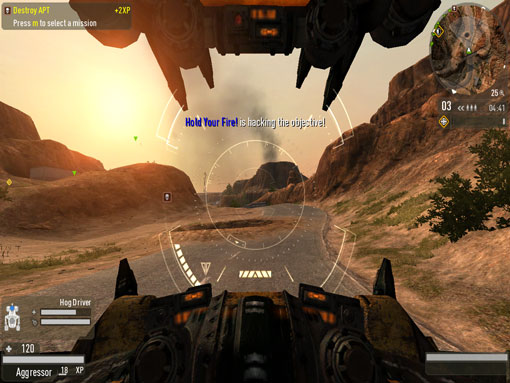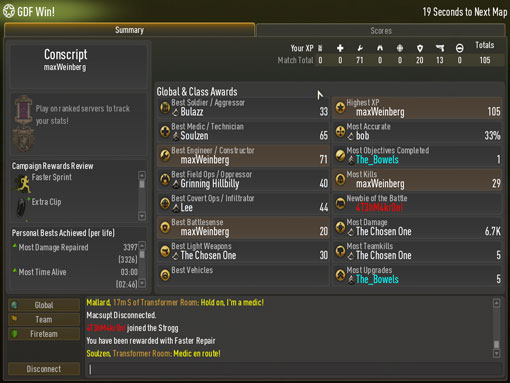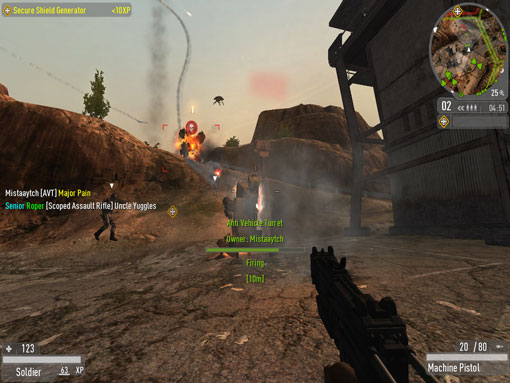Reviews: Hardcore Strogg on Strogg action
At first glance, Enemy Territory: Quake Wars from developer splash damage doesn't seem to distinguish itself: it's built on ground already covered by recent games like Unreal Tournament 3 and Team Fortress 2. Like both of those games, it's designed as an on-line multiplayer experience, yet another fragfest arena in a market in desperate need of fresh ideas. It offers off-line bot contests for practice like Unreal. And it uses the role-based team formula that Team Fortress 2 does so well. Despite these surface similarities, Enemy Territory does bring a unique perspective to the genre, earning a place among the best on-line shooters of the year.
First off, Enemy Territory offers great map design. It offers a wide variety of terrains, ranging from desert to urban to wintry landscapes, mixing together elements so no map is a monotonous collection of rolling hills or burnt-out buildings. For instance, the Strogg side of a particular desert map feels like a small town out of Pontecorvo's Battle of AlgiersЧthick stucco and stone walls with twisty little alleys, courtyards and tight spaces. The GDF side of the same map is open, hilly desert terrain with little cover and the occasional outpost building here and there. There are also some areas in maps that have an old-school УdungeonФ feel to them, complete with underground corridors, chambers and alcoves, perhaps appropriate considering the Quake-Doom heritage of the game.
All the maps have the requisite ledges, hiding places and passages that make for great on-line funЧthere's plenty there for any type of player, whether you favor sniping, run and gun, or more team-oriented play. On one map, I found a way to jump from the roof of one building onto a narrow ledge on the side of a hill, shimmy along the ledge, and then jump onto another roof that looked down onto a primary enemy objective. The maps are exciting to play because they feel like real places, not just arenas set up for players to blast away at one another. For instance, a small town area has houses with porches and back yards that make senseЧand they also happen to be great places for players to frag one another to bits, with choke points and open areas that keep things fun. On top of that, the maps always feel open-ended, with multiple paths to most places, with the Strogg's Icarus gravpack giving even more freedom. The Icarus is a sort of jetpack that allows Strogg players to jump all over the map and reach the tops of buildings and hills that might have otherwise been inaccessible.

The maps are made even more engaging by the way splash damage has built the mission objectives into a rich storyline. Of course, this is an on-line shooter that we're talking about here, so the story is pretty simple; there's no real plot or characters to speak of. But the basic situation is implemented well in each objective of each level. The situation is extremely simple: the Strogg, an advanced alien civilization, have invaded Earth, and the Global Defense Force (GDF) must repel the invasion. For most games, this would be enough of an excuse to throw together some Capture the Flag or Team Deathmatch levels, box them up, and call it a day. In the case of Enemy Territory, the mission goals build on the storyline, which in turn makes the game a more engaging experience. For instance, one level has the Strogg players protecting a УslipgateФ from the GDF forcesЧas the story goes, if the GDF players can hack the gate's controls, they'll get access to an important Strogg base. In just a few lines of story, splash damage gives each team a motivation for the fight. And what really puts that map over the top is that if the GDF does hack the slipgate, they can use it to transport to another location: the terrain changes from desert to snow and the GDF is within striking distance of a key Strogg installation.

Most of the scenarios have that same kind of Уobjective in depthФ setup, meaning that completing one goal leads to another that in turn leads to another. Several maps use a territory capture setup, where one team takes up the offensive and tries to roll across the map, pushing the other team back towards a main headquarters area, creating a dramatic tension not present in many on-line shooters. The defenders see the enemy getting closer and closer to their goal, so they fight harder and harder to hold back the advance before the timer runs out. The offensive team gets the rush of rolling forward and working together toward a goal. Plain old deathmatch or team deathmatch pales in comparison.
Enemy Territory's maps are full of that kind of exhilarating momentЧplayers are frequently called upon to defend objectives, call fire support, and more to get their blood flowing. The key to making this work is the game's class system. It's a symmetrical system, with the same five roles for both the GDF and Strogg teams, with a particular role having basically the same abilities regardless of which team he's on. For instance, there's a basic infantry class called Aggressor for the Strogg and Soldier on the GDF side, and each has the choice of an assault rifle, rocket launcher or light machine gun. They both also have access to explosive charges they can use to detonate enemy radar and artillery pieces and cause a little confusion behind the front lines. While the soldier class has the firepower, some of the other classes have more complex missions, making them more fun to play. For instance the Field Ops/Oppressor class can build artillery and missile batteries and then sneak forward into enemy territory to call artillery on spawn points, vehicles, and other key assets. The Engineer/Constructor builds anti-vehicle and anti-personnel turrets and repairs any damaged equipment, including vehicles. The engineers also disarm enemy explosive charges placed by enemy troops. Only Medics/Technicians can distribute health packs (there are no health or ammo drops) and revive combatants near death. If a player isn't immediately killed by enemy fire, he's incapacitated until either he Уtaps outФ to respawn or a medic arrives to revive him.
If the classes are mostly similar across the two teams, the vehicles show a little more variety. Both sides have a heavy tank, though the experience of driving each is very different. The Strogg Desecrator is a hover vehicle, with the ability to settle down into an immobile mode that's more protected from enemy fire. The GDF Titan battle tank has a dual set of machine guns that can wreak havoc among enemy ground troopsЧdriving it feels like grinding a sixty-ton across the landscape. And the Strogg have the Goliath, a walking mecha tank armed with twin lasers and a heavy machine gun. Like a lot of on-line games, the vehicles in Enemy Territory are potent and capable of dealing a whole lot of death in a short time. On the other hand, they're vulnerable to enemy anti-vehicle turrets and infantry armed with rocket launchers, so their lives tend to be brief and explosive.

Each side also has access to air support, a set of vehicles that are extremely difficult to pilot. The Strogg have an anti-armor/anti-personnel vehicle called the Tormentor, a a lightly-armored hovercraft that can quickly tear into exposed troops or tanks. Meanwhile the GDF have two aircraft, one that's great for moving troops and another that has a guided missile that's good against ground or air targets. All of these aircraft are potent, but they really take a lot of practice to even get off the ground and moving in the a useful direction. The mouse controls the attitude of the vehicle, whether its nose is pointed to the sky or toward the ground, but it's not a direct connection the way the mouse look functions for a character on the ground. You move the mouse and the vehicle responds, so you have to learn how much to move the mouse to get the desired effect. Fortunately, the game offers an off-line campaign in which you can fight against bots as you learn to fly.
Last but not least, Enemy Territory provides an extensive set of achievements and other features that create an engaging on-line experience. The server browser is easy to use and offers plenty of options for finding and filtering servers. One nice little feature is a УhistoryФ tabЧif you play a server, it's automatically stored in your history so you can find it again even if you forgot to add it to your favorites. And the well-developed set of achievements records a wealth of detail about your play, everything from damage done, kills, to objectives completed are used to award persistent medals to anyone who plays in ranked matches. Many achievements are also based on the class and team you play, so there are plenty of them to keep you going. The medals aren't all that easy to earn, though. After an evening of battles on a ranked server, I had earned 113 experience points toward the 600 needed for the lowest Engineer medal. The top Soldier medal requires a whopping 12,000 XP and 200 completed objectivesЧplenty of incentive for the hardcore to keep playing to earn those bragging rights. The only downside to this is that the game only permanently records your stats on ranked servers.
